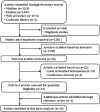Nonsteroidal anti-inflammatory drugs use and risk of Parkinson disease: A dose-response meta-analysis
- PMID: 30212946
- PMCID: PMC6155958
- DOI: 10.1097/MD.0000000000012172
Nonsteroidal anti-inflammatory drugs use and risk of Parkinson disease: A dose-response meta-analysis
Abstract
Previous studies have indicated that nonsteroidal anti-inflammatory drugs (NSAIDs) use is associated with Parkinson disease risk, but presented controversial results.Medline, Embase, Web of Science, and the Cochrane Database were searched update to November 2017. Key data were extracted from eligible studies. A dose-response meta-analysis was conducted for synthesizing data from eligible studies.Fifteen eligible studies were included in this meta-analysis. NSAIDs use was not associated with Parkinson disease risk [relevant risk (RR): 0.06; 95% confidence interval (95% CI), 0.91-1.02]. Subgroup analysis showed that aspirin use (RR: 1.14; 95% CI, 0.98-1.30) or ibuprofen use (RR: 1.01; 95% CI, 0.88-1.17) was not associated with Parkinson disease risk; however, the use of non-aspirin NSAIDs was significantly associated with Parkinson disease risk (RR:0.91; 95% CI, 0.84-0.99). Furthermore, NSAIDs use was not associated with the risk of Parkinson disease in female (RR: 0.99; 95% CI, 0.83-1.17) and male (RR: 1.01; 95% CI, 0.88-1.16). In addition, a dose-response showed per 1 number of prescription incremental increase in NSAIDs use was not associated with the risk of Parkinson disease (RR: 0.96; 95% CI, 0.91-1.02), per 1 year of duration of NSAIDs use incremental increase was not associated with the risk of Parkinson disease (RR: 0.98; 95% CI, 0.92-1.03), and per 1 dosage of NSAIDs use incremental increase was not associated with the risk of Parkinson disease (RR: 0.98; 95% CI, 0.95-1.02).NSAIDs use was not associated with the risk of Parkinson disease. The potency and the cumulative NSAIDs use did not play critical roles.
Conflict of interest statement
The authors report no conflicts of interest.
Figures




Similar articles
-
Non-steroidal anti-inflammatory drugs and risk of Parkinson's disease in the elderly population: a meta-analysis.Eur J Clin Pharmacol. 2019 Jan;75(1):99-108. doi: 10.1007/s00228-018-2561-y. Epub 2018 Oct 2. Eur J Clin Pharmacol. 2019. PMID: 30280208 Review.
-
Anti-inflammatory drugs and risk of Parkinson disease: a meta-analysis.Neurology. 2010 Mar 23;74(12):995-1002. doi: 10.1212/WNL.0b013e3181d5a4a3. Neurology. 2010. PMID: 20308684 Free PMC article. Review.
-
Use of ibuprofen and risk of Parkinson disease.Neurology. 2011 Mar 8;76(10):863-9. doi: 10.1212/WNL.0b013e31820f2d79. Epub 2011 Mar 2. Neurology. 2011. PMID: 21368281 Free PMC article.
-
Cardiovascular Risk of Nonsteroidal Anti-inflammatory Drugs and Classical and Selective Cyclooxygenase-2 Inhibitors: A Meta-analysis of Observational Studies.J Clin Pharmacol. 2019 Jan;59(1):55-73. doi: 10.1002/jcph.1302. Epub 2018 Sep 11. J Clin Pharmacol. 2019. PMID: 30204233
-
Aspirin and non-steroidal anti-inflammatory drugs use reduce gastric cancer risk: A dose-response meta-analysis.Oncotarget. 2017 Jan 17;8(3):4781-4795. doi: 10.18632/oncotarget.13591. Oncotarget. 2017. PMID: 27902474 Free PMC article.
Cited by
-
Association of Tooth Loss with New-Onset Parkinson's Disease: A Nationwide Population-Based Cohort Study.Parkinsons Dis. 2020 Jul 13;2020:4760512. doi: 10.1155/2020/4760512. eCollection 2020. Parkinsons Dis. 2020. PMID: 32765825 Free PMC article.
-
Epidemiological Evidence for an Immune Component of Parkinson's Disease.J Parkinsons Dis. 2022;12(s1):S29-S43. doi: 10.3233/JPD-223180. J Parkinsons Dis. 2022. PMID: 35661019 Free PMC article. Review.
-
Novel Applications of NSAIDs: Insight and Future Perspectives in Cardiovascular, Neurodegenerative, Diabetes and Cancer Disease Therapy.Int J Mol Sci. 2021 Jun 21;22(12):6637. doi: 10.3390/ijms22126637. Int J Mol Sci. 2021. PMID: 34205719 Free PMC article. Review.
-
The Contribution of Microglia to Neuroinflammation in Parkinson's Disease.Int J Mol Sci. 2021 Apr 28;22(9):4676. doi: 10.3390/ijms22094676. Int J Mol Sci. 2021. PMID: 33925154 Free PMC article. Review.
-
Inhibition of Protein Aggregation and Endoplasmic Reticulum Stress as a Targeted Therapy for α-Synucleinopathy.Pharmaceutics. 2023 Jul 30;15(8):2051. doi: 10.3390/pharmaceutics15082051. Pharmaceutics. 2023. PMID: 37631265 Free PMC article. Review.
References
-
- Ascherio A, Schwarzschild MA. The epidemiology of Parkinson's disease: risk factors and prevention. Lancet Neurol 2016;15:1257–72. - PubMed
-
- Teismann P, Ferger B. Inhibition of the cyclooxygenase isoenzymes COX-1 and COX-2 provide neuroprotection in the MPTP-mouse model of Parkinson's disease. Synapse 2001;39:167–74. - PubMed
-
- Hirsch E, Hunot S. Neuroinflammation in Parkinson's disease: a target for neuroprotection? Lancet Neurol 2009;8:382–97. - PubMed
-
- Hunot S, Hirsch E. Neuroinflammatory processes in Parkinson's disease. Ann Neurol 2003;(53 suppl 3):S49–58. discussion S58-S60. - PubMed
-
- Lanas A, Hirschowitz B. Toxicity of NSAIDs in the stomach and duodenum. Eur J Gastroenterol Hepatol 1999;11:375–81. - PubMed
Publication types
MeSH terms
Substances
LinkOut - more resources
Full Text Sources
Other Literature Sources
Medical

